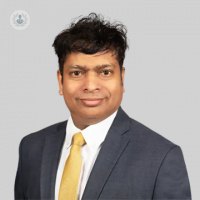Scoliosis in children: From diagnosis to management
Escrito por:Scoliosis is a common condition that often develops during childhood or adolescence. While mild cases may go unnoticed, more severe curves can cause discomfort, impact posture, and affect overall health. Early detection and proper management are crucial to ensure children with scoliosis lead active, healthy lives. Leading consultant paediatric orthopaedic surgeon Mr Shobhit Verma explores the causes, symptoms, and treatment options for scoliosis in children, helping parents and caregivers better understand this condition and its impact on growing bodies.

What is scoliosis?
Scoliosis is a condition characterised by an abnormal sideways curvature of the spine, typically diagnosed between infancy and early adolescence.
Key facts about scoliosis
- You may be born with scoliosis or may develop it later in life.
- Generally, scoliosis typically begins between the ages of 10 and 15.
- The curvature can occur on one or both sides of the spine and is usually C-shaped, though it can also be S-shaped.
- The angle of the curve can reach up to 45 degrees, and it is more commonly observed in girls.
The anatomy of the spine
A child’s spine consists of three main sections: the neck (cervical spine), the chest and mid-back (thoracic spine), and the lower back (lumbar spine). The spine is composed of bones known as vertebrae, which are stacked on top of each other like blocks, forming a vertical line along the back.
In scoliosis, the vertebrae curve to one side and twist, causing the child to appear to lean in that direction.
What are the various types of scoliosis?
Idiopathic: Scoliosis with no identifiable cause.
Congenital: Often hereditary, this type occurs when the spine does not develop correctly during pregnancy.
Neuromuscular: Scoliosis can arise from specific disorders affecting the brain, spinal cord, or muscular system, such as cerebral palsy or muscular dystrophy.
Other Causes: Scoliosis can also result from injuries, infections, or, although rare, tumours in the spine.
What are the main symptoms of scoliosis?
Most cases of scoliosis are mild and do not affect a child’s appearance, health, or cause any pain or disruptions in daily activities.
However, in some children, the condition may worsen as they grow, leading to more severe scoliosis that can be painful and disabling. This can result in back pain, physical limitations, and other health complications.
Other noticeable symptoms may include:
- A sideways curve in the child’s spine.
- Uneven hips, waist, and shoulders.
- A shift in the waist and trunk to one side.
- The head not aligned directly above the pelvis.
- Muscle spasms and prominent ribs.
- Difficulty walking or standing up straight.
- Fatigue and shortness of breath.
- Numbness, weakness, or leg pain.
Diagnosing scoliosis in children
Early diagnosis is crucial for treating scoliosis. The doctor will begin by taking a thorough medical and growth history of your child.
Next, a physical examination is performed, where the doctor may ask your child to stand and bend forward to assess the spine. The curve of the spine will be evaluated from the front, back, and sides. A neurological exam may also be done to check for any signs of muscle weakness.
To confirm the diagnosis and assess the severity of the curvature, imaging tests such as X-rays, MRI scans, or CT scans may be ordered.
Treating scoliosis in children
Factors considered before treating scoliosis in children include the following:
- The severity of the curve.
- The curve pattern.
- The location of the curve.
- The progression of the curve.
- Your child’s age.
In cases of very mild scoliosis, treatment is often unnecessary as the condition may improve over time. However, moderate to severe scoliosis may require treatment with a back brace or surgery.
It should be noted that children with mild scoliosis (a spinal curve of less than 20 degrees) may require regular check-ups to monitor any changes in the curvature as they grow. The doctor may recommend periodic X-rays to track the condition and determine if further treatment is necessary.
Back bracing
If your child is still growing and has moderate scoliosis (a curve between 20 and 40 degrees), the doctor will likely recommend a back brace to prevent the curve from worsening. Most braces are worn discreetly under clothing and are not noticeable. Children wearing braces can typically engage in most activities and maintain their daily routines.
Surgery
Severe scoliosis (curve of more than 45 degrees) typically progresses with time. In such cases where the condition worsens despite conservative treatments, the doctor might suggest surgery to halt the condition’s progress. The most common type of scoliosis surgery is spinal fusion. Scoliosis surgery repairs the abnormal curvature and safely straightens your child's spine.
What happens if scoliosis is left untreated?
If scoliosis is left untreated, it can affect heart and lung function, potentially leading to additional health complications.
If you are concerned that your child has scoliosis and would like to book a consultation with Mr Mr Verma, simply visit his Top Doctors profile today


